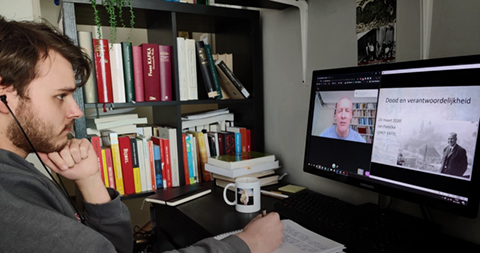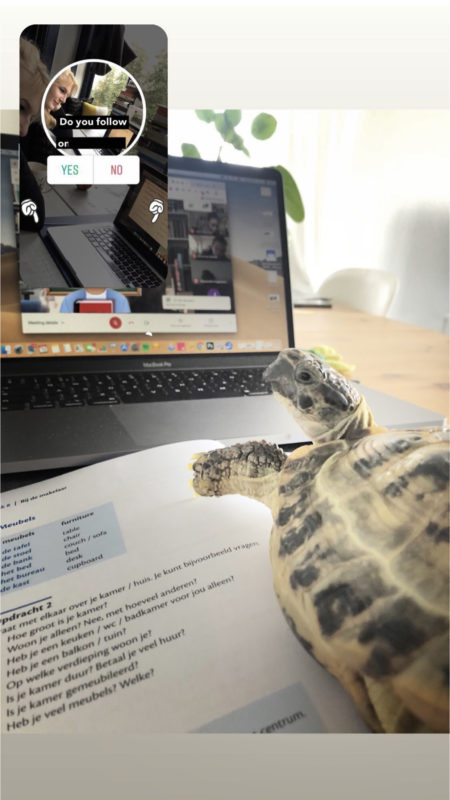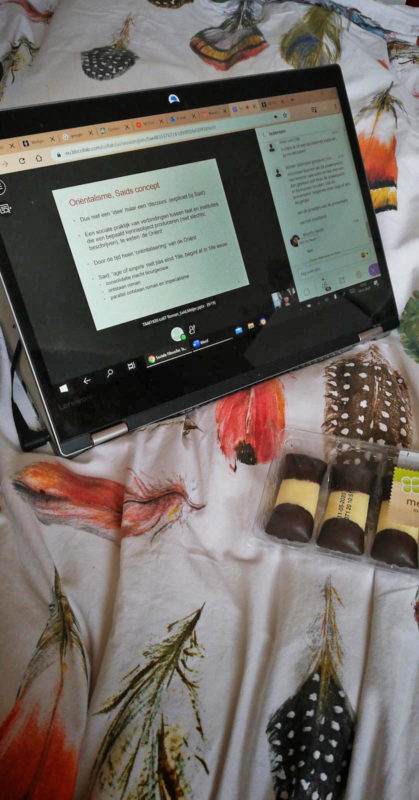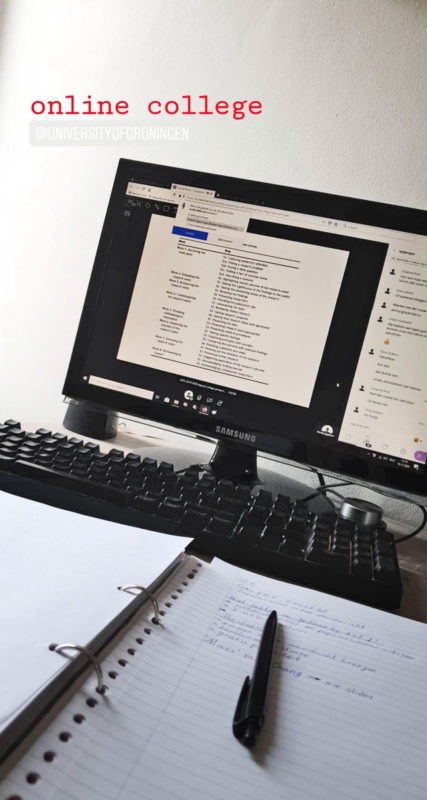
The sudden switch to digital education
‘Huh! It actually works pretty well’

Health law professor Brigit Toebes did not sleep well two weekends ago. She calls herself computer-illiterate and doesn’t really know how to work the machines or use online tools. But even she had to make the sudden switch to online teaching last week. ‘I was nervous all weekend’, she says.
The first thing she did when she heard that physical classes were cancelled was check Nestor. To her surprise, she found everything she needed to teach online classes. She also discovered that there were plenty of people at her service to teach her how to use the necessary tools. ‘There was this older man who took me through it, step by step’, says Toebes. ‘He understood my troubles.’
Sweaty palms
Last week, Toebes found herself at her computer with sweaty palms, ready to teach a lecture that would normally involve her walking around the room with a microphone to let students ask questions. Now, her students had to ask their questions through a chat programme, even if only eighty of the normal two hundred had logged on.
‘But to be honest’, she says, ‘everything went really well.’ The students were happy and there was plenty of interaction. What’s more, they found it easier to ask questions.
I was nervous all weekend
Across the university, students and lecturers have been making the switch to online education. Some people already knew their way around. ‘I’d used the tools before’, says accounting lecturer Derk-Jan Heslinga. ‘But I’d never needed to before like I do now.’ For other lecturers, the switch was challenging. Nevertheless, everyone found out that things were possible that we never knew about.
Critical
Jennifer Spenader, assistant professor of language and cognition at the department of artificial intelligence, cancelled her first class, which was scheduled for the day after the university’s shutdown was announced. To prepare for the next one, she took the CIT webinar and had her colleague Malvin Gattinger coach her. ‘He had really helpful tips. Like: have a student or a TA in the room. When students are asking questions on the chat, that can be really distracting when you’re talking. But a TA can interrupt and do a little interview.’

Her class went well, although she’s critical of her own performance. ‘I’m very enthusiastic and energetic. Normally I walk around the room, make jokes, but now you’re just not able to communicate in the same way’, she says.
But she was pleasantly surprised by all the facilities the UG has available, like the discussion board, which allows students to ask questions. It’s a useful tool, and she’ll definitely keep using it. She also discovered new possibilities to upload and even grade assignments. She thinks this might save her TAs a lot of work in the future.
Adjustment
Even economics professor Eelko Hak, who for the longest time was opposed to recording classes, concluded that the technology worked satisfactorily. He thoroughly prepared using Nestor support, did a test run, and now suspects that we’ll be able to keep using this technology even after the corona crisis has passed. ‘There are definitely opportunities here for international students’, he says.
Forced by the coronavirus to use Nestor, many students are discovering the tools that have been available for ages. Students also had to make the switch. It’s been an adjustment, says engineering management student Ruben Heinsbroek. ‘We’re using Blackboard Collaborate, but this one time, there were two folders. The seventy of us were in the wrong folder. It took us thirty minutes to realise the professor was in the other one. That was a bummer, because it meant we’d missed quite a bit of the lecture.’
The professor was in another folder, so we missed half an hour of the lecture
The situation is not ideal, he says. ‘A lot of my teachers explain things by writing them on the blackboard. They can’t do that now. Courses like mine, which involve a lot of calculations, are made more difficult by being online.’ He does appreciate it, though. ‘I think it’s great that the classes are still on. They could’ve also just put some PowerPoint slides online and told us to figure it out.’
Easier

Many classes are running at least as smoothly as when the students attended them in person. ‘The system glitches every once in a while’, says Laura Wielaert, one of Eelco Hak’s pharmaceutical students. ‘But only sporadically. And we learn more. Asking questions is easier now.’
‘Everything is working’, agrees media student Iza Valkema. ‘The lecturer’s voice cut out every once in a while, but it wasn’t a big deal. I think I’m learning the same way I do in a normal class.’
There might be quite a few drawbacks to this way of teaching, but lecturers and students both see the advantages, as well. ‘The chat function has its charms’, says Hak. ‘I like the option of getting immediate feedback when I’m going too fast.’
‘I take screen captures of my calculations and put them together like a slide show’, says Heslinga. ‘It’s a great way to combine synchronous and asynchronous learning.’
‘I can imagine maybe doing small videos later’, says Spenader. ‘About topics that people struggle with. That might actually work.’
Less awkward
Students are glad that they can rewatch classes later; finally, people have stopped protesting putting materials online. Students attend classes from their beds and say that asking questions is not just easier, but that they also feel less awkward about it. ‘In a classroom, you have to raise your hand and the whole room stops what it’s doing. Especially when there’s 150 people in there. Now, it’s less conspicuous, even if you’re worried you might say something stupid’, says Laura.
It’s less conspicuous if you say something stupid
Nevertheless, some people are concerned. How many students are actually coming to class? Toebes’ class has two hundred students, but only eighty of them logged on for her first online class. Hak has 240 students. Only half of them were online. It’s possible the other half might watch the class later, but maybe they’re just giving up. ‘I’m really worried’, says Toebes. ‘How do we engage these young people?’
Let’s not forget the laboratory classes, which can’t be taught at all. No one yet knows how to make up for this once all this is over. Students and lecturers both are worried about how this will affect exams. ‘The entire situation is strange and confusing’, says law and Middle Eastern studies student Nine van den Wijngaard.
Something biological
In the end, everyone is eager to get back to teaching and taking classes in person. ‘In my class I show this video on language learning’, says Spenader. ‘They have a Mandarin speaker speak Mandarin to American babies via a TV. But the babies don’t learn Mandarin. But when the Mandarin speaker is physically with the babies, the babies do learn.’
She’s convinced that online classes will never be a true substitute for physical classes. ‘When you teach online, there’s something vital missing, something biological that helps people learn.’

